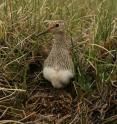Lover's lane for birds found in Arctic
A new study by the Wildlife Conservation Society reveals the critical importance of western Arctic Alaska's Teshekpuk Lake region to tens of thousands of birds that breed in the area during the brief, but productive arctic summers, and makes clearer the case for permanent protection of the area. Results of the four-year study—the first to look at the full suite of bird species from around the world that descend on the Teshekpuk Lake region—showed that the region contains some of the highest nesting bird densities and nest productivity across Alaska's Arctic.
The study appears in the March issue of the peer-reviewed journal Arctic. Authors include Joe Liebezeit and Steve Zack of the Wildlife Conservation Society; and Gary White, a statistician from Colorado State University.
"This is the first study to investigate breeding bird densities and measure how well birds are able to produce young in this remote and important region near Teshekpuk Lake," said the study's lead author, Joe Liebezeit. "We found that the density of nesting birds was markedly higher compared to many other sites in Arctic Alaska."
The Teshekpuk Lake Special Area (TLSA) in the National Petroleum Reserve –Alaska (NPR-A) has long been recognized as an important site for wildlife. Tens of thousands of geese migrate there to molt in summer and a 70,000-strong Caribou herd—critical to North Slope natives for subsistence hunting —calves its young in the TLSA.
The Teshekpuk study site exists within a portion of the TLSA that was temporarily withdrawn by the Bureau of Land Management (BLM) from oil and gas leasing consideration in July of 2010 over concerns for wildlife.
WCS North America Program Director Dr. Jodi Hilty said, "Given the results of this study, and previous studies conducted by WCS and other scientists, we recommend that the region of 10-year development deferral be granted permanent protection. "
During the study, WCS scientists calculated nest densities (number of nests per unit of area) at the remote Teshekpuk site. Those results were compared to six other areas (including both human impacted and remote sites) where nest densities were measured in previous studies. The results showed that Teshekpuk densities far exceeded those at the other locations.
Additionally, nests were periodically monitored every 3-6 days at Teshekpuk and at a site in the Prudhoe Bay region 150 miles to the east where oil extraction activities are occurring. Results showed that for some species, nest survivorship (production of young) was higher at Teshekpuk.
WCS's Conservation Zoologist Steve Zack said: "Teshekpuk Lake is in the middle of the world's biggest Arctic wetland, and thus at the heart of an international migration of shorebirds, waterfowl, loons, and songbirds that nest in this highly productive region during the short summer. This study makes clear how valuable this region is to breeding birds."
Currently, BLM is evaluating how best to balance wildlife protection and future energy development in the NPR-A. WCS has been engaged in the western Arctic for 10 years, identifying where wildlife protection would be most effective in the NPR-A in advance of development. The results of the study will help inform BLM's decision-making process.
Source: Wildlife Conservation Society
Other sources
- Arctic Wetland Is Lover's Lane for Birdsfrom Newswise - ScinewsFri, 11 Mar 2011, 4:31:54 UTC
- 'Lover's lane' for birds found in Arcticfrom Science DailyThu, 10 Mar 2011, 21:20:53 UTC
- Arctic Wetland Is Lover's Lane for Birdsfrom Newswise - ScinewsThu, 10 Mar 2011, 19:31:20 UTC
- Lover’s lane for birds found in Arcticfrom Science BlogThu, 10 Mar 2011, 18:00:26 UTC
- Lover's lane for birds found in Arcticfrom PhysorgThu, 10 Mar 2011, 17:01:05 UTC
